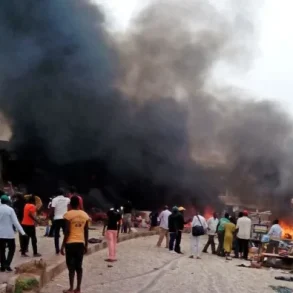By Adedoja Samuel Adesoji
The Yoruba believe that death is inevitable, hence, the popular adage ‘awaye i ku kosi, orun nikan lare mabo’; that is, no one has ever come to this world without dying, it is only heaven that you go and not return.
Even though there is no scientific evidence of survival after death, it is a generally held belief among the Yoruba that the soul of the dead continues to exist after death.
Funeral rites (Ìsìnkú) among the Yoruba is not just limited to burying the corpse, but involves a chain of rituals that are performed prior and after the burial of the deceased, the
circumstances surrounding the death and the religious affiliation of the deceased, as well as the community to which the deceased belonged.
In some communities, the first step taken after the death of a person is to ascertain the cause of death. If the person died of natural cause for instance, it is expected that a ritual be performed to avert the departed from further molestation of the evil spirits as well as dangers that may befall family members from such fate. There are some rituals to be performed when some iconic people die. For example, an Oba, hunchbacks, pregnant women, hunters etc.
In the Yoruba tradition, the actual burial of the corpse is a preceding event to the funeral process. During the interment, the offspring, relations, associates and well wishers gather together to pay last respect.
Ìsìnkú refers to the burial rites which are the final steps carried out for or regarding a person or people who have passed on. For someone who has lived a good and long life, the passing is celebrated with dancing, merry and joy. However, there are other types of death which are seen as very saddening, such as the death of children.
Where a sad death has occurred, there is no fanfare or celebration; the deceased are buried quickly and people mourn.
Traditionally, causes of death are typically classified under one of these categories
Àìsàn (Illness),
ijànbá óríṣiríṣi (unforeseen mishaps/ accidents),
ikú Àìtọ́jọ́ (untimely/premature death) =
ifọwọrọríkú (dying peacefully)
Steps taken when someone dies
Ìtúfọ̀ (announcement)
Before publicly breaking the news, the deceased is covered with white cloth and the surroundings redone and prepared for mourners and comforters, so that the corpse is met in a decent state.
Money for the announcement and money for the land where the deceased is to be buried is paid.
Ìtọ́jú òkú (caring for the corpse)
The corpse is given a bath, taking extra care with the soap and sponge to make it as clean as possible ( male corpses are bathed by males, while female corpses are bathed by females). Male corpses would have their heads shaved and are dressed; female corpses get a new hairdo and be clothed. Other than the clothes worn, the corpse is then “packaged” in a variety of other clothes.
The deceased body is wrapped in several native cloths, and positioned on a mat at the door of the room. At this point, a fowl called ‘adiye irana’ (the farefowl) is slain which is believed, would make the road stress-free for the deceased as he journeys into heaven. While the lying-in-state is on-going, a yam is prepared and a share of it is positioned at the foot of the platform where the corpse is laid. This food is considered as food for the departed while the principal mourners, the widows and daughters of the
deceased are isolated and exempted in the death-feast that follows.
Títẹ́ òkú ní ìtẹ́ ẹ̀yẹ (lying in state)
After the corpse has been given a bath and dressed up in white, perfumes are used on the deceased on a mat. The body openings such as the mouth, nose and ears are blocked with cotton wool. The place is decorated and laid out in the open whilst women of the household praise, hail and chant the oriki of the deceased.
How is the burial conducted?
Back in the days, the oldest person in the house was buried in the room or in the room used to entertain guests. When it is time to bury the person, the corpse is put into the coffin with ẹ̀ko tútù (cold pap), wine, kolanut, white kola nut , aṣọ (clothes), bàtà (shoes), ọ̀pá ìtìlẹ̀ (walking stick), ìlèkè (beads), ọkọ́ (hoe) , àdá (swords) and ọ̀bẹ (knives). Money as well is given to the corpse to be used on the way to heaven.
The first born of the deceased throws the first soil of the dug grave on the coffin in the grave before other family members.
With tears and more pouring of soil by other family members, they bid farewell to the deceased and ask that he or she greet other late loved ones in heaven. This is followed by more greetings and hailing of the deceased.
What follows next is entertainment of the people and other burial-related activities and hospitality for guests. Drinks and food are provided if money is available, but the festivities can be postponed if the family is strapped for cash. After seven days, there is a celebration for the coming out period after the burial.
Tradition for widows
When a woman becomes a widow, she mourns and stays indoors for between 40 days and three months. She also does not engage in bright clothing or wearing of jewellery. However, widowers are not expected to sleep alone. Another woman sleeps with him, so that the dead wife won’t come and be by his side.
In modern times, burial-related events are heavily influenced by Christianity and Islam, with little traditional elements or practices retained. Praise singing, celebrating a good life, communal regard for the dead and assistance alongside hospitality towards guests are still very key till this day in Yoruba death and burial events.
What new things have you learned and what did you find most interesting about the things related to burial procedures in Yorubaland?
Let us know what other topics you’d like us to talk about.






